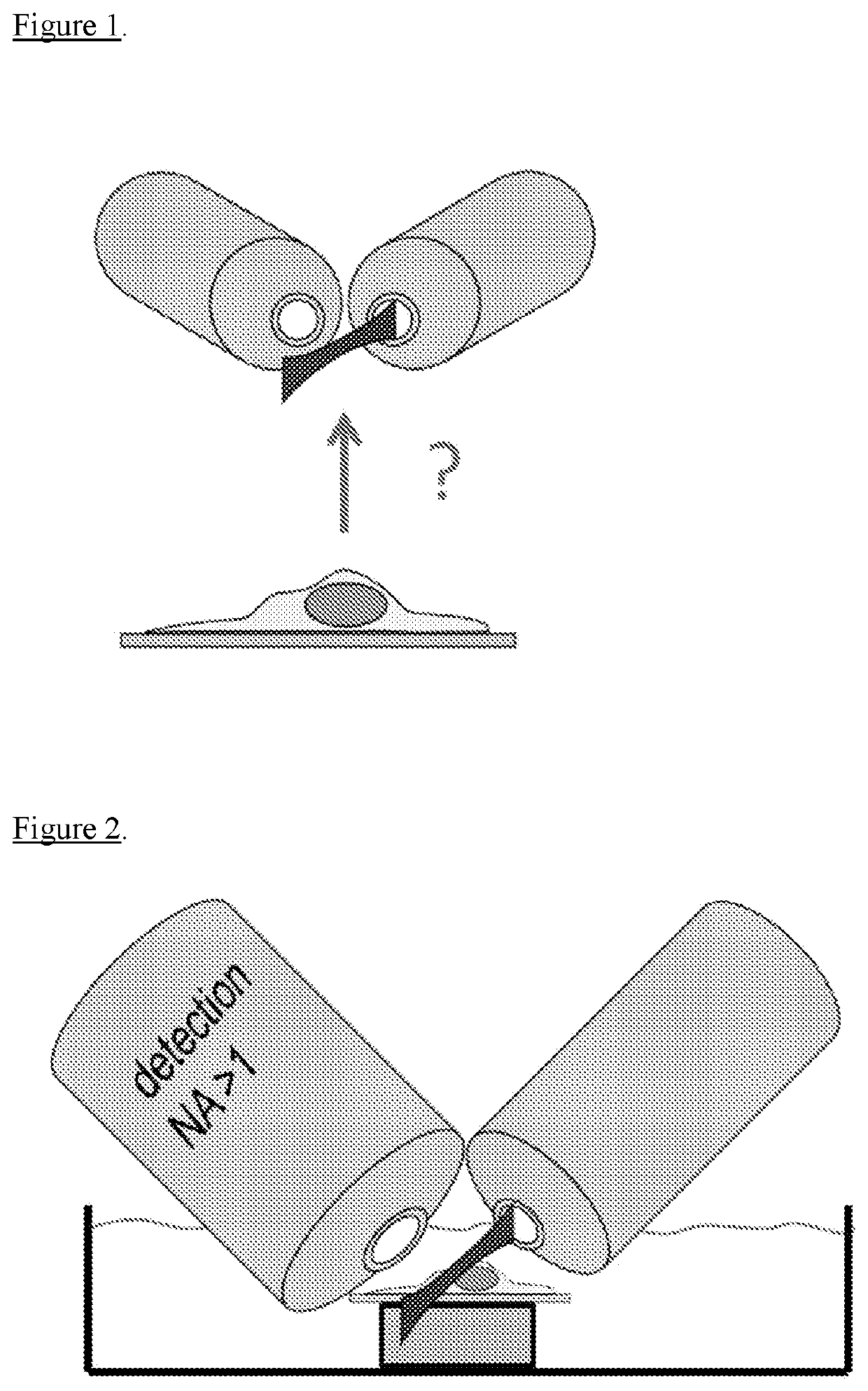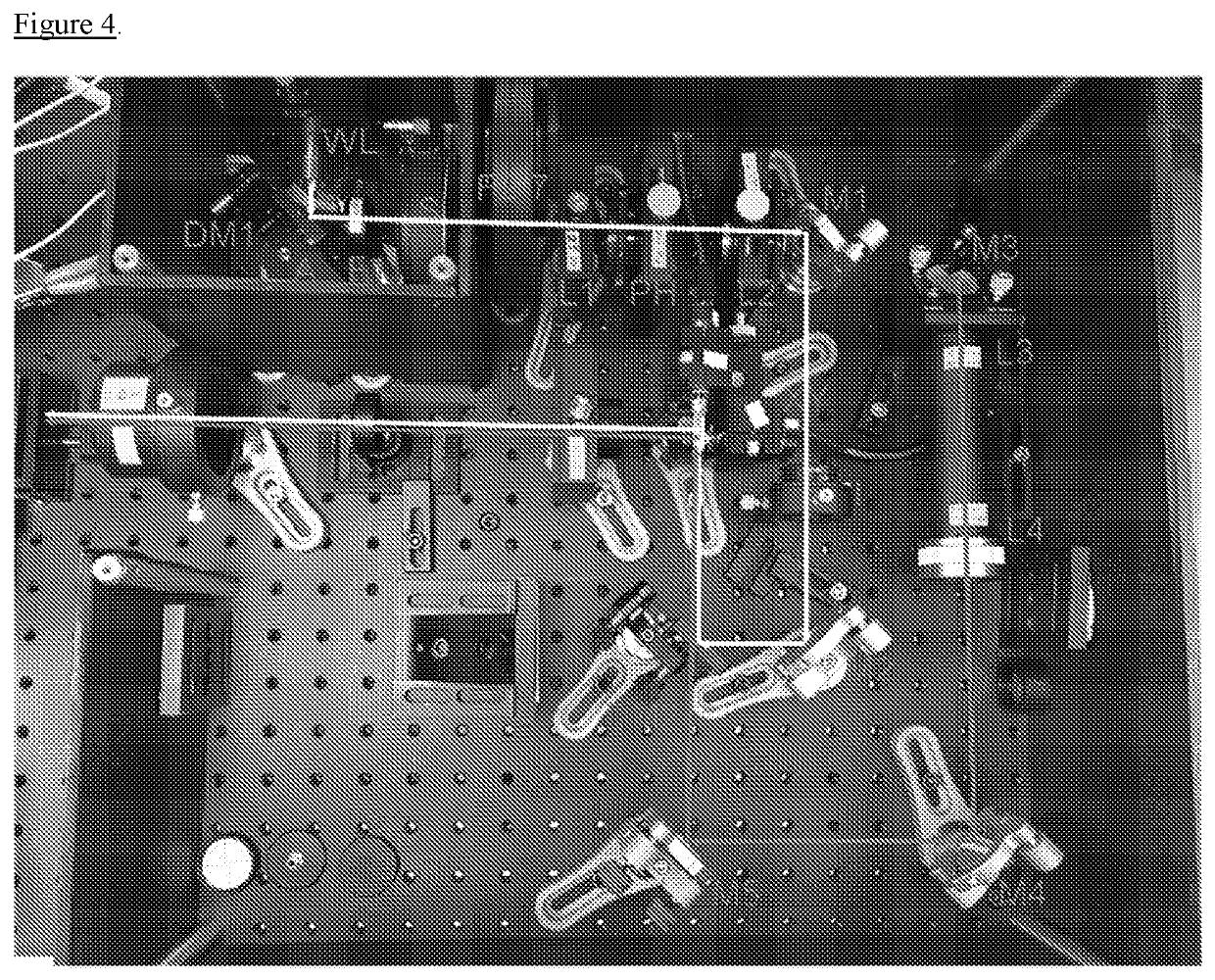Selective plane illumination in the conventional inverted microscope geometry by side illumination
a technology of inverted microscope and side illumination, applied in the field of microscopy, can solve the problems of large immersion volume, increase the amount of reagents needed, and no separation of optics and samples, and achieve the effects of maximizing field of view, high throughput, and stable mounting
- Summary
- Abstract
- Description
- Claims
- Application Information
AI Technical Summary
Benefits of technology
Problems solved by technology
Method used
Image
Examples
example 1
Generally
[0050]Selective plane illumination microscopy (SPIM) is one of the most suitable techniques for fast, three-dimensional imaging. By confining the excitation light to a sheet, SPIM combines axial sectioning capability with minimal light exposure and fast, camera-based image acquisition. SPIM typically uses two (objective) lenses arranged perpendicular to each other. One lens is used for light detection, while the focal plane of that lens is illuminated with a sheet of light generated via the other lens. To generate the light sheet, cylindrical optics can be used. Alternatively, the beam can be rapidly scanned across the field of view of the detection lens to generate the sheet illumination. However, the arrangement of two objective lenses perpendicular to each other provides a number of challenges in terms of instrument design and sample geometry as explained in the following.
[0051]Initially SPIM was designed around the specimen with excitation and detection in the horizonta...
example 2
Components of SideSPIM
[0054]In one embodiment, the three key components of the sideSPIM include:
[0055]1) Side illumination unit. All optical components required to generate the light sheet illuminating the sample are mounted onto a single platform. This unit can be coupled to any inverted microscope.
[0056]2) Two window sample chamber. With two optically transparent windows perpendicular to each other, the light to generate the sheet illumination at the sample plane can be introduced from the side. Magnetic attachment of the chamber to the microscope stage ensures easy to handle, stable and reproducible mounting.
[0057]3) Refractive index matching. By raising the sample inside the chamber well using an optically transparent material with a refractive index identical to the sample immersion fluid, samples can be imaged distortion free all the way to the bottom. Index matching also allows imaging of flat samples such as a monolayer of cells in the first place.
example 3
Side Illumination Unit
[0058]One embodiment of the sideSPIM prototype is illustrated in FIG. 3. The system is based on an inverted microscope (IX71 fitted with epifluorescence illumination unit, Olympus) with camera detection (Edge 4.2, PCO). A motorized xy stage (MS-2000, ASI) holds a piezo xyz-stage (NANO-PDQ375, Mad City Labs) fitted with a custom magnetic sample holder inset. The stage assembly is raised by 36 mm using spacers to make room for the objective lens of the side illumination unit located on the left. Besides being installed onto the same flat and rigid mounting surface (Smart Table UT2, Newport), no further mechanical connections from to side illumination unit to the microscope body are required. A more detailed view of the side illumination assembly is shown in FIG. 4.
[0059]With this unit, the light sheet is generated and injected into the sample. The assembly consists of a white laser source, WL (SC 390, Fianium), for excitation with visible light. From the fiber ou...
PUM
 Login to View More
Login to View More Abstract
Description
Claims
Application Information
 Login to View More
Login to View More - R&D
- Intellectual Property
- Life Sciences
- Materials
- Tech Scout
- Unparalleled Data Quality
- Higher Quality Content
- 60% Fewer Hallucinations
Browse by: Latest US Patents, China's latest patents, Technical Efficacy Thesaurus, Application Domain, Technology Topic, Popular Technical Reports.
© 2025 PatSnap. All rights reserved.Legal|Privacy policy|Modern Slavery Act Transparency Statement|Sitemap|About US| Contact US: help@patsnap.com



